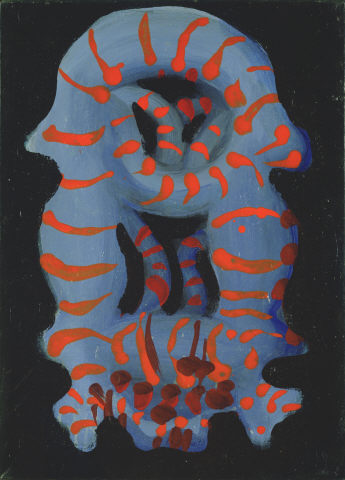
Untitled
In the early 1970s, José Escada conducted numerous experiments with ropes, forming clusters, skeins, and balls wound into pine cones and head shapes, but at times also featuring bodies entwined in a dense and fertile tangle. Images with a rich and complex symbolism beneath a humble appearance, in which the figure of the serpent (e.g. in the “Laocoön” that the artist also depicted), appears to emerge repeatedly, like in the work we are interpreting here.
Using the same heraldic economy that we find, for example, in the Modern Collection paintings with monograms and locks, this painting exhibits a recurring metaphor in José Escada’s work: the metaphor of life, a primordial energy that animates living things, depicted in serpentine tubes, flexible and pneumatic entities endowed with their own breath. Its intertwining structure suggests the perpetual movement of union and interaction, a dynamic common to all living organisms, whether at the microscopic level of cells and molecules or at the level of tissues and organs, as with the human brain. The human capacity for thinking is, therefore, symbolised here in this bluish-grey cortex with its curves and convolutions, primordial matter and site of all representations. Its fundamental properties, conduction and excitability, are reflected in short bands of bright, intense red, which reinforce the undulating, vigorous fluorescence of the matter. Reiterating the homology between cords and cortex, knots of imagination and thought, the grey (literally painted) matter is transfigured into a jellyfish or snake. In this way, we are able to contemplate the other face of the life spirit, according to José Escada. It is a tempestuous, negative face, in which the threads, wrapped around themselves, prefigure the threatening image of the labyrinth. This substance of passive appearance, therefore, manifests itself as a viscous trap capable of submerging the self. The ropes that Escada theorised repeatedly did not always produce a positive, ascensional tension. Rather they revealed viscid, dissolving matter, the product of which – ideas or thought –, according to the artist, could give rise to the most suffocating uniformity.
Ana Filipa Candeias
Learn more